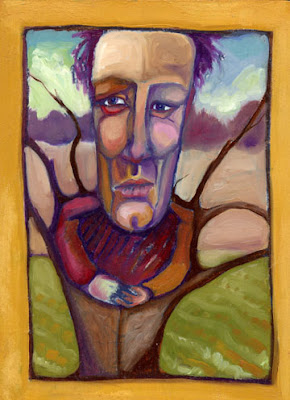It was a Godawful year for fruits on this hill: with early heat, then late frosts, hail later on, followed by a long summer drought... all perfectly ordered as if by a Godman Bully.
The Cherries straightened up after the heavy snow, but few flowers and fruits made it through the
hail. My best Plum flowered so heavily it looked like it was still covered with snow...but then brown knots of fungus swelled all over the branches, so I had to cut the tree back to little more than a coat rack.
When you add to that a wayward raccoon and wayward mink that wiped out all but one of my chicken flock, I might be tempted to just raise mice and cats.
But my Pear orchard here at Dog's Plot is going to be all right.
Very few pears this year, and trees here lost most of their fuit, but the trees themselves are going to flourish.
Pears originated in the extreme conditions of mountain Asia, and ever since the French Jesuit Missionaries brought them here..... a couple hundred year before White settlement..... have been evolving and adapting to the local clay .
The Jesuits had been in Canada ever since well before the Mayflower pilgrims showed up on the East coast..and they also had fingers into Iroquois country south of Lake Ontario, including two missions at native settlements on Cayuga Lake. And where the Jesuits went, they took their gardens with them.
The village now aappropriately called Aurora is in a deep valley with a ridge to the east
that makes the morning last hours longer than if you live up here on the hill where the sky is big,
the geese scrape by just overhead, and the West wind blows the pumpkins around. The village was known as Deawendote, or Village of the Constant Dawn before the Jesuits arrived, later as Chonodote (which maybe somebody can tell me the meaning of) and then called Peachtown by the soldiers who chopped down the orchards there. In the mild climate at lake level the Cayugas planted not only their own three sister vegetables, but also French vegetables and trees. For all we know, the Cayuga may have been growing Broccoli and Arugula here.
But it IS known that the Jesuits brought Peaches, Cherries, Apples and Pears to Deawendote, which around then became known as Chonodote,
After two hundred years of constant-dawn and advancing garden culture, the Cayugas, who were by then living in wood frame houses like the French and English, chose the loyalist side in our war between the Anglos; so General Sullivan's troops, ordered by Washington, and led by William Butler, marched up and down along the Finger Lakes, slashing and burning Iroquois villages.
There were no Broccoli survivors at Chonodote, nor did most of those non native fruit trees persist, but the Pears are all around us.
If you cut down a pear tree, it will sprout dozens of little clone Pear trees from
the stump . Quick-growing, short-lived brush and perenials come up first on brunt and abandoned land, but Pears have plenty of time, rise like church spires and then spread white flower crowns.....flowering and fruiting year after year, the seedlings creeping up the slopes.
Even in regularly mowed hayfields, gnarly old gnome pears, kept to four or six inches tall, but with deep root systems, are ready to take over when we give up mowing. Pears can live for hundreds of years. Pears can wait.
Dog's Plot had not been mowed for five or ten years before I arrived. For the first few years, I planted fruit trees and didn't even notice the pears, or if I did, thought they were crab apples. The naturalalized Pears devolve from the cultivated varieties and tend to be small, round, and even bitter.
But in the last few years I have transformed most of them with grafting.










